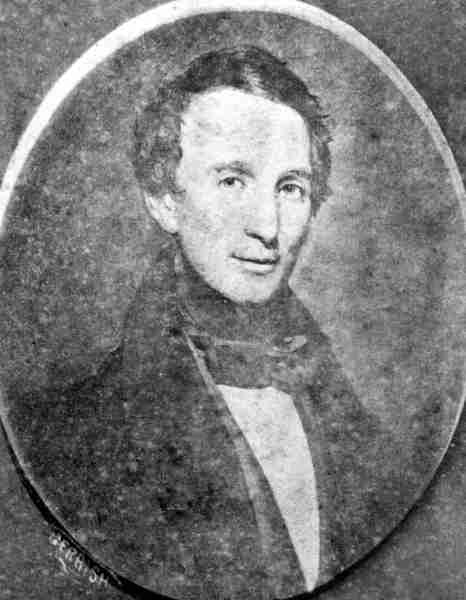(8 October 1797 – 9 October 1837)
Q5640675
Information compiled by Carol Ann McCormick, Curator of the University of North Carolina at Chapel Hill Herbarium.
Special thanks to Starla Glenn, University of North Carolina at Chapel Hill Alumni Records, and to Lisa Giencke of the Joseph W. Jones Ecological Research Center at Ichauway for information on Goodwood Estate & Gardens.
The University of North Carolina at Chapel Hill Herbarium (NCU) has catalogued a single specimen collected by Hardy Bryan Croom, Torreya taxifolia collected in Aspalaga, West Florida in 1833. Other herbaria curating Croom’s specimens include Harvard University (GH), New York Botanical Garden (NY), and the Academy of Natural Sciences (PH).1
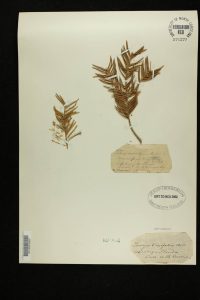
Croom’s estate in Tallahassee, Florida is now Goodwood Museum & Gardens. “The estate known as Goodwood was assembled in the 1830s by Hardy Croom of North Carolina. Plans for a full-time Florida residence were dashed when he, his wife, and three children perished in the sinking of their steamship while en route to Florida. Bryan Croom, Hardy’s brother, completed the Main House at Goodwood and established it as the centerpiece of his extensive Florida landholdings.”2
Hardy Bryan Croom is best known to botanists as the discoverer of Torreya taxifolia. He is the namesake of Croomia (Stemonaceae), a genus of three species, two in China & Japan, and one in the southeastern United States. Croomia pauciflora (Nuttall) Torrey is a rare plant found in moist bluff forests in Georgia, Alabama, and Florida.
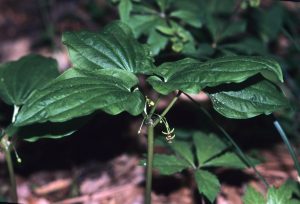
EXCERPTS FROM: Redfearn, D. H. (1935) The Steamboat Home: Presumption as to order of death in a common calamity. Florida Law Journal, Vol IX, May 1935, No.5: 405-424.
Hardy Bryan Croom was born in Lenoir County, North Carolina on October 8, 1797. He was graduated with an A. B. degree at the University of North Carolina in the class of 1817; he also received an A.M. degree from that institution in 1820. He derived a handsome fortune from the estate of his father, William Croom. In 1821 he married Frances Smith, the daughter of Nathan Smith, a wealthy citizen of New Bern, NC. He had large planting interests in Lenoir County, NC and represented that county in the state senate in 1828. He resigned his seat in the senate to go to Florida to look after investments. In 1831 he sold his plantation in Lenoir County and removed his plantation negroes to Florida. He divided his time among the enjoyment of his family circle, the care of his estate and his literary pursuits. Geology, mineralogy and botany were his favorite subjects. He was a member of the Philosophical Society of SC, a corresponding member of the Academy of Natural Sciences of Philadelphia, and of the New York Lyceum of Natural History. He was interested in the flora of Florida. In 1832 he obtained a plantation in Florida on the west bank of the Apalachicola River near Marianna. He also purchased and began the development of a plantation in Leon County, which he was induced to purchase “on account of its desirable location for a family residence, being but three miles distant from the City of Tallahassee, the capital of the Territory, in the centre of good society, pleasantly situated on the border of Lake Lafayette, and combining many advantages for a permanent family seat.”
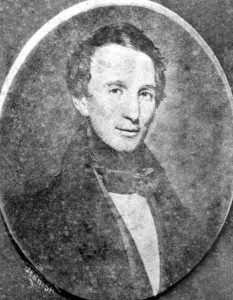
It was in passing from this plantation to the one near Quincy that he discovered one of the rarest of coniferous trees, which he named Toreya taxifolium [sic]. There are four species of this tree, of remarkable distribution, according to the “New International Encyclopedia,” second edition. All the species are very local and very widely separated, occurring in restricted localities in China, Japan, California and Florida. After Mr. Croom ascertained that it was the first discovered in the United States of this species of coniferous tree, he desired that it should bear the name of Dr. John Torrey, a famous botanist of that time living in the city of New York, with whom he had collaborated in botanical work. Mr. Croom also discovered in Florida the botanically curious little plant which Dr. Torrey named Croomia panciflora [sic] in his honor.
A number of Mr. Croom’s articles appeared in botanical journals. There are three papers in the American Journal of Science and Arts, volumes 25, 26 and 28, published in 1834 and 1835, entitled “Botanical Observations” [see PUBLICATIONS, below].
Hardy Bryan Croom made annual pilgrimages to Leon and Gadsden counties, Florida, from 1830 to 1837. His family lived in New Bern, North Carolina and spent their summers in New York city and in Saratoga. His brother, Bryan Croom, came to Florida in 1826 and established his first home in Gadsden county, which he called Rocky Comfort. He later built Goodwood, in Leon county. … Despite the discouraging report from his brother, Bryan Croom, Hardy determined in 1837 to establish a summer residence in Charleston, South Carolina, and to move his family, who were then visiting in New York city, to Florida by Sea voyage to Charleston and thence to Tallahassee by private conveyance. … [Hardy Bryan Croom] and his family took passage on the steamboat Home on Saturday, October 7, 1837 from New York to Charleston, and all members of the family perished in the wreck of that steamboat on the night of October 9, 1837… There were on board approximately ninety passengers and forty members of the crew, including officers. A storm was encountered on Sunday afternoon, October 8, 1837. The boat proved to be unseaworthy and, on the next day, off Cape Hatteras, in order to keep it from foundering, the passengers, including women and children, were compelled to resort to bailing with buckets, pails, and pans. Despite all efforts the water finally extinguished the fire under the boiler and at approximately eight o’clock Monday night; then, with the assistance of a sail, an attempt was made to drive the sinking boat on the shore south of Cape Hatteras. The following is quoted from an account written a few days after the wreck by Mr. B.B. Hussey, one of the passengers.
At about eleven o’clock, those who had been employed in bailing were compelled to leave the cabin, as the boat had sunk until the deck was nearly level with the water; ant it appeared too probably that all would soon be swallowed up by the foaming waves. The heaving of the lead indicated an approach to the shore. Soon there was the cheering intelligence of ‘Land! Land!’ announced by those on the look out. This, for a moment, aroused the sinking energies of all, when a general bustle ensued, in the hasty, but trifling preparations that could be made for safety, as soon as the boat should strike. But what were the feelings of an anxious multitude, when, instead of land, a range of angry breakers were visible in the distance far beyond… The boat, at length, strikes, — it stops – as motionless as a bar of lead. A momentary pause follows, — as if the angel of death shrank from so dreadful a work of slaughter. But soon the work of destruction commenced. A breaker, with a deafening crash, swept over the boat, carrying its unfortunate victims into the deep. At the same time, a simultaneous rush was made toward the bow of the boat. The forward deck was covered. Another breaker came, with irresistible force, — and all within its sweep disappeared. Our numbers were now frightfully reduced. The roaring of the waters, together with the dreadful crash of breaking timbers, surpasses the power of description. …
This wreck occurred south of Cape Hatteras, and a few miles north of Ocracoke Inlet to Pamlico Sound… and approximately ninety out of the one hundred thirty passengers and crew were dead. There were only two life preserves on board, and they were privately owned. … The New York Evening Post on October 18, 1837, carried an article on life preservers and stated that, as a result of the wreck of the steamboat Home, a requirement had been made that other boats be equipped with [life preservers].
THE CROOM CASE, 7 Fla. 81
As a result of the wreck of the steamboat House, one of the most interesting cases in the legal history of Florida was filed in the circuit court of Leon County on the 24th day of January, 1839… The two main issues in this case were: first, whether the father, the mother, or one of the children was the last survivor; and second, whether North Carolina or Florida was the domicile of the father at the date of his death. If the father survived the other members of the family, then his estate went to his brothers and sister. If the mother survived the other members of the family, then she inherited the estate before her death, and upon her death it went to her relatives. If one of more of the childrn [sic] survived their parents, and if North Carolina was their domicile, all the personal property would be distributed to the maternal next of kin, under the laws of North Carolina then existing; but, if Florida was the domicile of this family, the personal property, which was the most valuable part of the estate, would be distributed between the maternal and paternal next of kin, under the laws of Florida then in force. …
In the trial of this case, the evidence of a number of survivors of the wreck as to the order in which the members of the Croom family died was taken… this evidence indicated that Mrs. Croom and the youngest child, Justina, aged 7, died first…the evidence of a number of other witnesses, indicated that Mr. Croom was the next member of the family to perish; that Henrietta Mary died next, and that William Henry was the last member of the family to die…
[The Supreme Court of Florida] held that, in the common calamity in which the Croom family perished, Hardy Bryan Croom survived his wife, Frances, and his daughter, Justina Rosa; that the daughter, Henrietta Mary, and the son, William Henry, survived their father; that William Henry survived his sister, Henrietta Mary, and was the last survivor of the family; that the domicile of Hardy Bryan Croom on the date of his death was in the state of North Carolina, and not in the territory of Florida, and that the domicile of the father at the time of his death was the domicile of Henrietta Mary and William Henry, the two children who survived him. Under this decision, the mother of Mrs. Croom, Henrietta Smith, obtained all the personal property, which was the most valuable part of the estate, and one-eighth of the real estate. Mrs. Elizabeth M. Armistead, the sister of Mrs. Croom, was awarded one-eighth of the real estate, and the heirs of Hardy Bryan Croom the remaining three-fourths. The real estate was governed by the laws of Florida, where it was located, and the personal property by the laws of North Carolina, the state of the domicile.
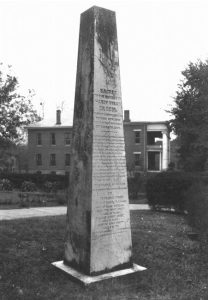
Epitaph on an obelisk in the churchyard of St. John’s Episcopal Church in Tallahassee, Florida:
SACRED TO THE MEMORY OF HARDY BRYAN CROOM
Born in North Carolina
October 8, 1797
Died near Cape Hatteras
October 9, 1837
Amiable without weakness, learned without arrogance, wealthy without ostentation, and benevolent without parade. He sought not the world’s admiration, but noiselessly pursued his path through life, finding his purest earthly pleasure in the bosom of his family, the society of his friends and the companionship of his books. The best tribute to his worth is to be found in the affectionate remembrance of those, who having known him from boyhood, loved him while living, and deplored him dead.
This marble seeks also to preserve the remembrance of
FRANCES H. CROOM,
wife of Hardy B. Croom,
and of their children,
HENRIETTA MARY CROOM,
aged 15 years,
WILLIAM HENRY CROOM,
aged 10 years,
JUSTINA ROSA CROOM,
aged 7 years,
all of whom perished with the unfortunate husband and father in the wreck of the steamboat “Home” on the night of the 9th of October, 1837.
Redfearn, p. 417: According to the Friday, October 27, 1837 issue of The Spectator, a weekly newspaper published in New Bern, NC, Mrs. F.H. Croom’s body was found near the scene of the wreck and buried “at Mr. Howard’s on Ocracoke,”… the body of her son, William Henry, was also found about three weeks later on the Portsmouth side of Ocracoke Inlet… among the old family records exhibited to me [Redfearn] by Mr. Francis B. Winthrop is a letter dated August 16, 1885, in which the statement is made that the body of Justina Rosa was recovered and brought to New Bern for burial also. The bodies of Hardy Bryan Croom and his eldest daughter, Henrietta Mary, were never recovered. The bodies of Mrs. Croom and her two children, William Henry and Justina Rosa, now repose in the Nathan Smith vault in Cedar Grove Cemetery, New Bern, N.C.
PUBLICATIONS:
Croom, H.B. (1834) ART. VII. – Botanical Communications: 1. Floral Calendar of Middle Florida, during a portion of the year 1833. II. Account of some new species of plants. III. New localities of Plants. American Journal of Science and Arts 25(1): 69-79.
Croom, H.B. (1834) ART. VII. – Botanical Communications: 1. Account of a new species of Plant. II. Localities of Plants. III. Remarks upon the genus SARRACENIA. IV. Remarks upon the Botany of Middle Florida. American Journal of Science and Arts 25(2): 313-320.
Croom, H.B. (1835) ART. XVII. – Botanical Communications: 1. Description of a new plant. I. Localities of Plants. American Journal of Science and Arts 28: 165-168.
SOURCES:
- SERNEC Data Portal. 2024. http//:sernecportal.org/index.php. Accessed on June 26.
- “History.” Goodwood Museum & Gardens. Goodwood Museum & Gardens, Inc., n.d. Web. 23 April 2013. http://www.goodwoodmuseum.org/history.php.
- Redfearn, D. H. (1935) The steamboat Home: Presumption as to order of death in a common calamity. Florida Law Journal IX (No. 5): 405-424.
